VEGA Grieshaber KG MIPU61 VEGAMIP 61 Radar Sensor User Manual Operating Instructions VEGAMIP U61 Relay
VEGA Grieshaber KG VEGAMIP 61 Radar Sensor Operating Instructions VEGAMIP U61 Relay
Users Manual
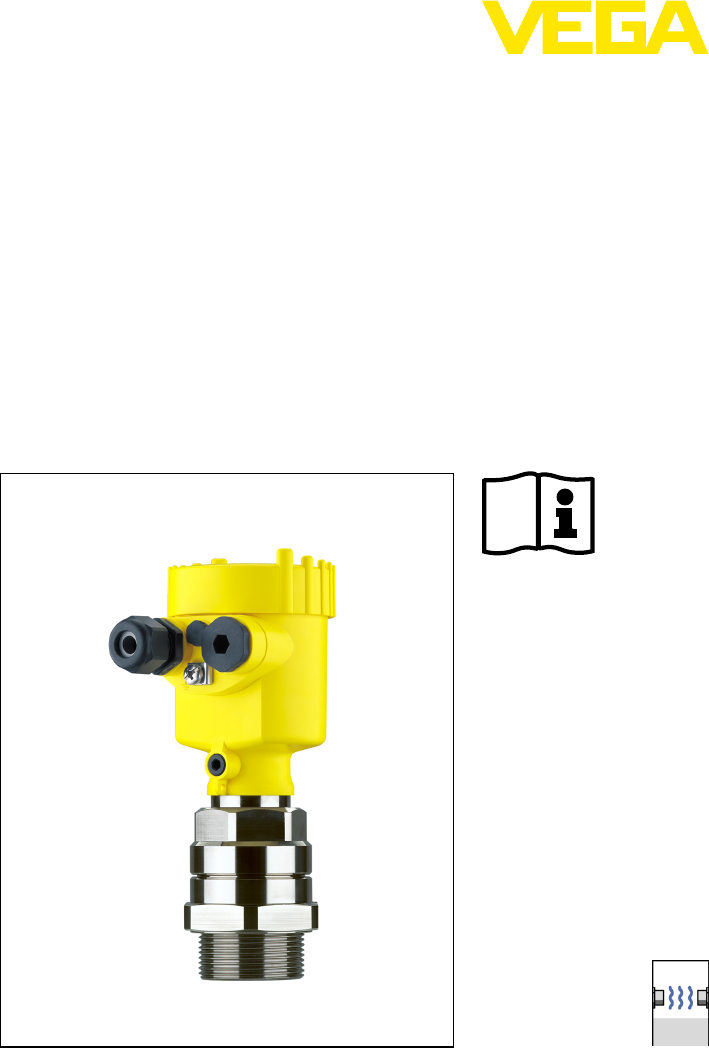
Operating Instructions
VEGAMIP U61
Receiving unit
-Relay
Document ID:
Radar

Contents
1About this document
1.1Function.................................. 4
1.2Target group .............................. 4
1.3Symbolism used............................ 4
2For your safety
2.1Authorised personnel ........................ 5
2.2Appropriate use ............................ 5
2.3Warning about misuse ....................... 5
2.4General safety instructions . . . . . . . . . . . . . . . . . . . . 5
2.5CE conformity ............................. 6
2.6Radio approval for USA/Canada . . . . . . . . . . . . . . . . 6
2.7Environmental instructions..................... 6
3Product description
3.1Configuration .............................. 7
3.2Principle of operation ........................ 7
3.3Packaging,transport and storage ............... 9
3.4Accessories and replacement parts . . . . . . . . . . . . . . 10
4Mounting
4.1General instructions ......................... 12
4.2Mounting instructions ........................ 12
5Connecting to power supply
5.1Preparing the connection ..................... 19
5.2Connection procedure........................ 19
5.3Wiring plan,single chamber housing . . . . . . . . . . . . . 21
6Setup
6.1Adjustment elements ........................ 22
6.2Adjustment................................ 23
7Maintenance and fault rectification
7.1Maintenance .............................. 28
7.2Rectify malfunctions ......................... 28
7.3Exchange the electronics ..................... 29
7.4How to proceed in case of repair. . . . . . . . . . . . . . . . 29
8Dismounting
8.1Dismounting steps .......................... 30
8.2Disposal ................................. 30
9Supplement
9.1Technical data ............................. 31
9.2Dimensions ............................... 34
2VEGAMIP U61 • - Relay
Contents
-EN-100531

Safety instructions for Ex areas
Please note the Ex-specific safety information for installation and
operation in Ex areas.These safety instructions are part of the
operating instructions manual and come with the Ex-approved
instruments.
VEGAMIP U61 • - Relay 3
Contents
-EN-100531
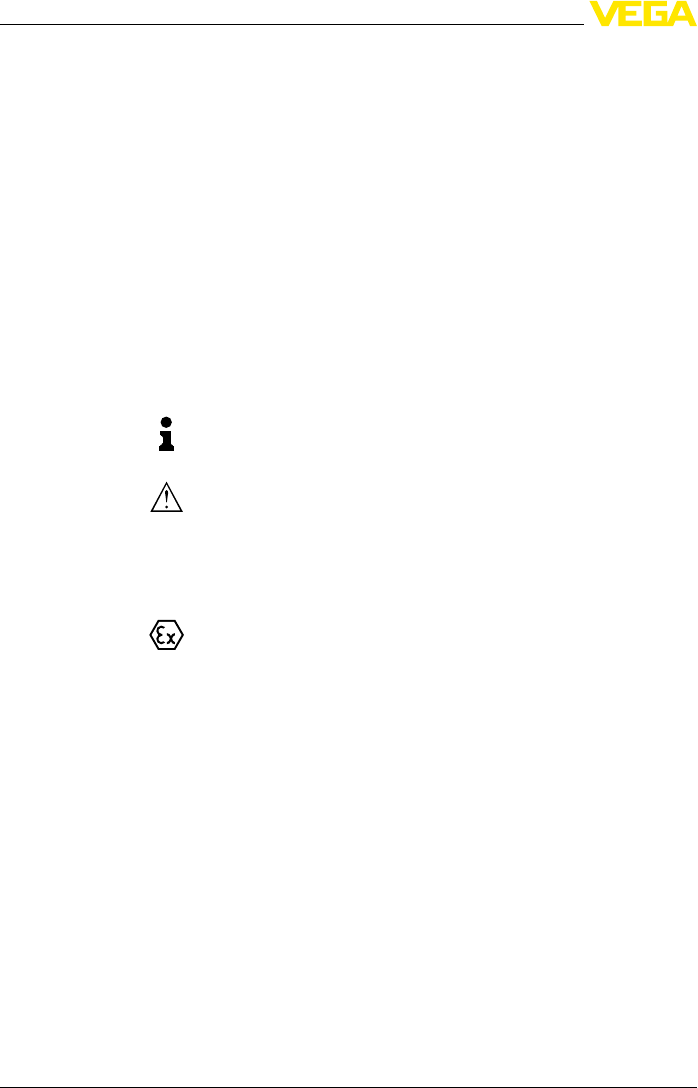
1About this document
1.1Function
This operating instructions manual provides all the information you
need for mounting,connection and setup as well as important
instructions for maintenance and fault rectification.Please read this
information before putting the instrument into operation and keep this
manual accessible in the immediate vicinity of the device.
1.2Target group
This operating instructions manual is directed to trained qualified
personnel.The contents of this manual should be made available to
these personnel and put into practice by them.
1.3Symbolism used
Information,tip,note
This symbol indicates helpful additional information.
Caution:If this warning is ignored,faults or malfunctions can
result.
Warning:If this warning is ignored,injury to persons and/or serious
damage to the instrument can result.
Danger:If this warning is ignored,serious injury to persons and/or
destruction of the instrument can result.
Ex applications
This symbol indicates special instructions for Ex applications.
lList
The dot set in front indicates a list with no implied sequence.
àAction
This arrow indicates a single action.
1Sequence
Numbers set in front indicate successive steps in a procedure.
4VEGAMIP U61 • - Relay
1About this document
-EN-100531

2For your safety
2.1Authorised personnel
All operations described in this operating instructions manual must be
carried out only by trained specialist personnel authorised by the plant
operator.
During work on and with the device the required personal protective
equipment must always be worn.
2.2Appropriate use
The VEGAMIP 61 is a sensor for level detection.
You can find detailed information on the application range in chapter
"Product description".
Operational reliability is ensured only if the instrument is properly used
according to the specifications in the operating instructions manual as
well as possible supplementary instructions.
2.3Warning about misuse
Inappropriate or incorrect use of the instrument can give rise to
application-specific hazards,e.g.vessel overfill or damage to system
components through incorrect mounting or adjustment.
2.4General safety instructions
This is a state-of-the-art instrument complying with all prevailing
regulations and guidelines.The instrument must only be operated in a
technically flawless and reliable condition.The operator is responsible
for the trouble-free operation of the instrument.
During the entire duration of use,the user is obliged to determine the
compliance of the necessary occupational safety measures with the
current valid rules and regulations and also take note of new
regulations.
The safety instructions in this operating instructions manual,the
national installation standards as well as the valid safety regulations
and accident prevention rules must be observed by the user.
For safety and warranty reasons,any invasive work on the device
beyond that described in the operating instructions manual may be
carried out only by personnel authorised by the manufacturer.Arbitrary
conversions or modifications are explicitly forbidden.
The safety approval markings and safety tips on the device must also
be observed.
VEGAMIP U61 • - Relay 5
2For your safety
-EN-100531

The emitting frequencies of the sensors depend on the model,but are
all in the Kband range.The low transmitting power lies far below the
internationally permitted limit value.When the instrument is used
correctly,it presents no danger to human health.It may be operated
without restriction outside of closed vessels.
2.5CE conformity
The device fulfills the legal requirements of the applicable EC
guidelines.By attaching the CE mark,VEGA provides a confirmation
of successful testing.You can find the CE conformity declaration in the
download area of www.vega.com.
2.6Radio approval for USA/Canada
FCC Note according to 15.21:Any changes or modifications not
expressly approved by the party responsible for compliance could void
the user's authority to operate the equipment.
FCC Statement for Part 15 (FCC allows the placement in the
manual only when the label is too small to place the statement):
this device complies with Part 15 of the FCC rules.Operation is
subject to the following two conditions: (1)This device may not cause
harmful interference,and (2)this device must accept any interference
received,including interference that may cause undesired operation.
IF Class Aor Class Bdigital device or peripheral FCC Compliance
Statement §15.105,Class Aor Bmust be included in the manual .
FCC-Statement for Part 15:This device complies with Part 15 of the
FCC rules.Operation is subject to the following two conditions: (1)
This device may not cause harmful interference,and (2)this device
must accept any interference received,including interference that may
cause undesired operation.
2.7Environmental instructions
Protection of the environment is one of our most important duties.That
is why we have introduced an environment management system with
the goal of continuously improving company environmental protection.
The environment management system is certified according to DIN
EN ISO 14001.
Please help us fulfil this obligation by observing the environmental
instructions in this manual:
lChapter "Packaging,transport and storage"
lChapter "Disposal"
6VEGAMIP U61 • - Relay
2For your safety
-EN-100531
Any changes or modifications not expressly approved by the party
responsible for compliance could void the user's authority to operate
the equipment.
This device complies with Part 15 of the FCC rules. Operation is
subject to the following two conditions: (1) This device may not cause
harmful interference, and (2) this device must accept any interference
received, including interference that may cause undesired operation.

3Product description
3.1Configuration
The type label contains the most important data for identification and
use of the instrument:
lArticle number
lSerial number
lTechnical data
lArticle numbers,documentation
With the serial number,you can access the delivery data of the
instrument via www.vega.com,"VEGA Tools"and "serial number
search".In addition to the type label outside,you can also find the
serial number on the inside of the instrument.
The serial number on the type label of the instrument allows you to
have the order data,operating instructions manuals,sensor data for
the service DTM as well as the test certificate (depending on the
instrument)displayed via www.vega.com,"VEGA Tools"and "serial
number search".
The scope of delivery typically consists of the following components.
lPoint level sensor VEGAMIP U61 (receiving unit)
lDocumentation
-this operating instructions manual
-Supplementary instructions manual "Plug connector for level
sensors"(optional)
-Ex-specific"Safety instructions"(with Ex versions)
-if necessary,further certificates
lThe corresponding emitting unit VEGAMIP T61 is described in a
separate operating instructions manual.
l
3.2Principle of operation
VEGAMIP 61 is a microwave barrier for level detection.
It is designed for industrial use in all areas of process technology and
can be used in bulk solids and liquids.
Typical applications are overfill and dry run protection.With an
operating distance of 100 m,VEGAMIP 61 can be used,for example,
in bulk solids silos with large diameters.Thanks to its simple and
rugged measuring system,VEGAMIP 61 is virtually unaffected by the
process and the chemical and physical properties of the medium.
VEGAMIP 61 can be also used for detection of vehicles and ships or
for material recognition on conveyor belts.
Type label
Serial number
Scope of delivery
Application area
VEGAMIP U61 • - Relay 7
3Product description
-EN-100531
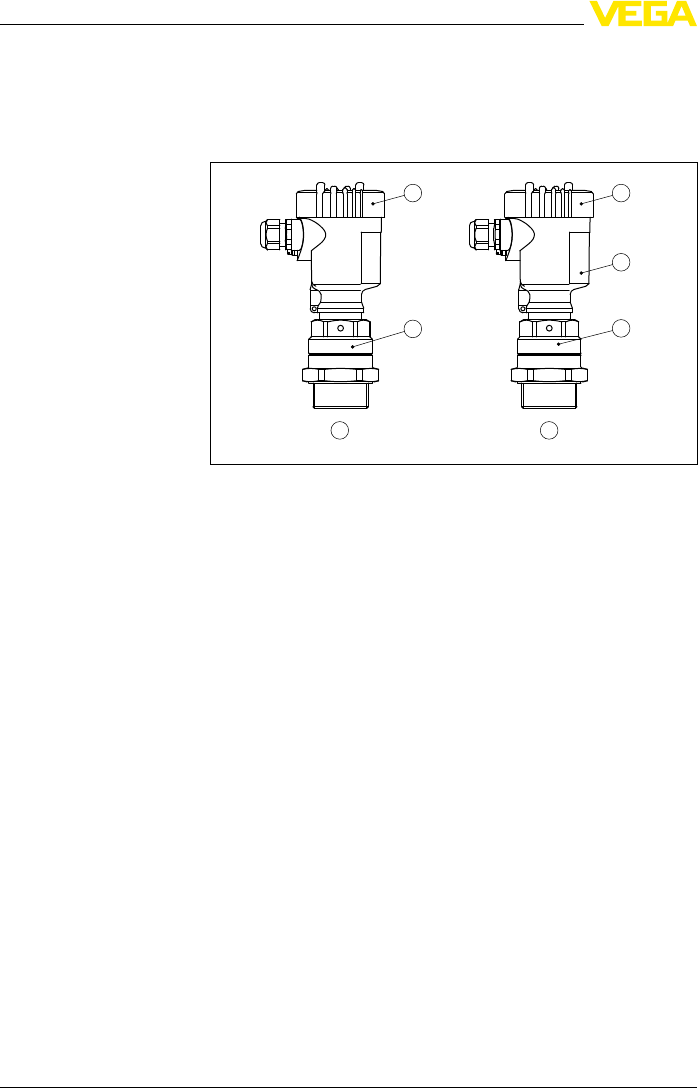
It works even under extremely difficult conditons,such as different
granulation sizes,contamination,extreme filling noise,high temper-
atures,strong dust generation or abrasive products.
The VEGAMIP 61 consists of the following components.
33
5
4
5
21
Fig.1:VEGAMIP 61 with plastic housing
1Emitting unit VEGAMIP T61
2Receiving unit VEGAMIP U61 with control electronics
3Housing cover
4Housing with control electronics
5Process fitting
8VEGAMIP U61 • - Relay
3Product description
-EN-100531
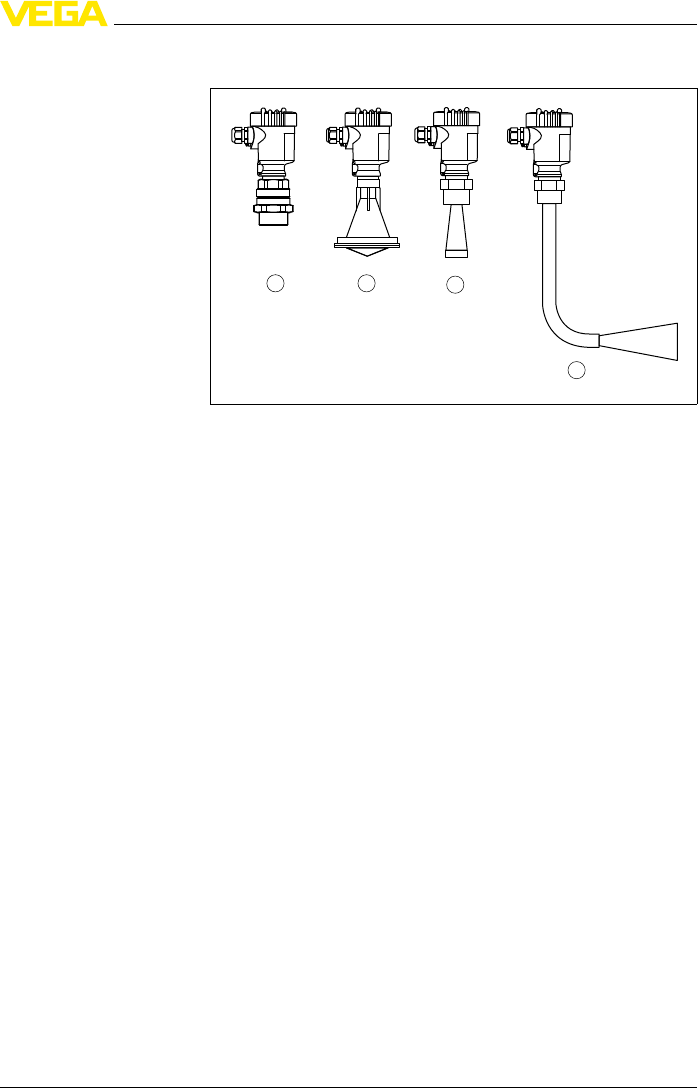
Several antenna versions are available for different applications.
1 2 3
4
Fig.2:Antenna versions
1Encapsulated horn antenna with PTFE cover
2Plastic encapsulated antenna with PP cover
3Horn antenna
4VEGAMIP 61 with angled antenna extension
The emitting unit transmits a focused microwave signal via horn
antenna to the receiving unit on the opposite side.If there is medium
between emitting and receiving unit,the signal is damped.This
change is detected by the built-in electronics module and converted
into a switching command.
3.3Packaging,transport and storage
Your instrument was protected by packaging during transport.Its
capacity to handle normal loads during transport is assured by a test
according to DIN EN 24180.
The packaging of standard instruments consists of environment-
friendly,recyclable cardboard.For special versions,PE foam or PE foil
is also used.Dispose of the packaging material via specialised
recycling companies.
Transport must be carried out under consideration of the notes on the
transport packaging.Nonobservance of these instructions can cause
damage to the device.
The delivery must be checked for completeness and possible transit
damage immediately at receipt.Ascertained transit damage or
concealed defects must be appropriately dealt with.
Functional principle
Packaging
Transport
Transport inspection
VEGAMIP U61 • - Relay 9
3Product description
-EN-100531

Up to the time of installation,the packages must be left closed and
stored according to the orientation and storage markings on the
outside.
Unless otherwise indicated,the packages must be stored only under
the following conditions:
lNot in the open
lDry and dust free
lNot exposed to corrosive media
lProtected against solar radiation
lAvoiding mechanical shock and vibration
lStorage and transport temperature see chapter "Supplement -
Technical data -Ambient conditions"
lRelative humidity 20 …85 %
3.4Accessories and replacement parts
The protective cover protects the sensor housing against soiling and
intense heat from solar radiation.
You will find additional information in the supplementary instructions
manual "Protective cover"(Document-ID 34296).
Flanges are available in different versions according to the following
standards:DIN 2501,EN 1092-1,ANSI B 16.5,JIS B 2210-1984,
GOST 12821-80.
You will find additional information in the supplementary instructions
manual "Flanges according to DIN-EN-ASME-JIS"(Document-ID
31088).
The electronics module VEGAMIP U61 is a replacement part for
microwave barriers of VEGAMIP series 60.
You will find additional information in the following operating
instructions manual:
l"Electronics module VEGAMIP U61 (receiving unit)"(Document-ID
36428)
Storage
Storage and transport
temperature
Protective cover
Flanges
Electronics module
10 VEGAMIP U61 • - Relay
3Product description
-EN-100531
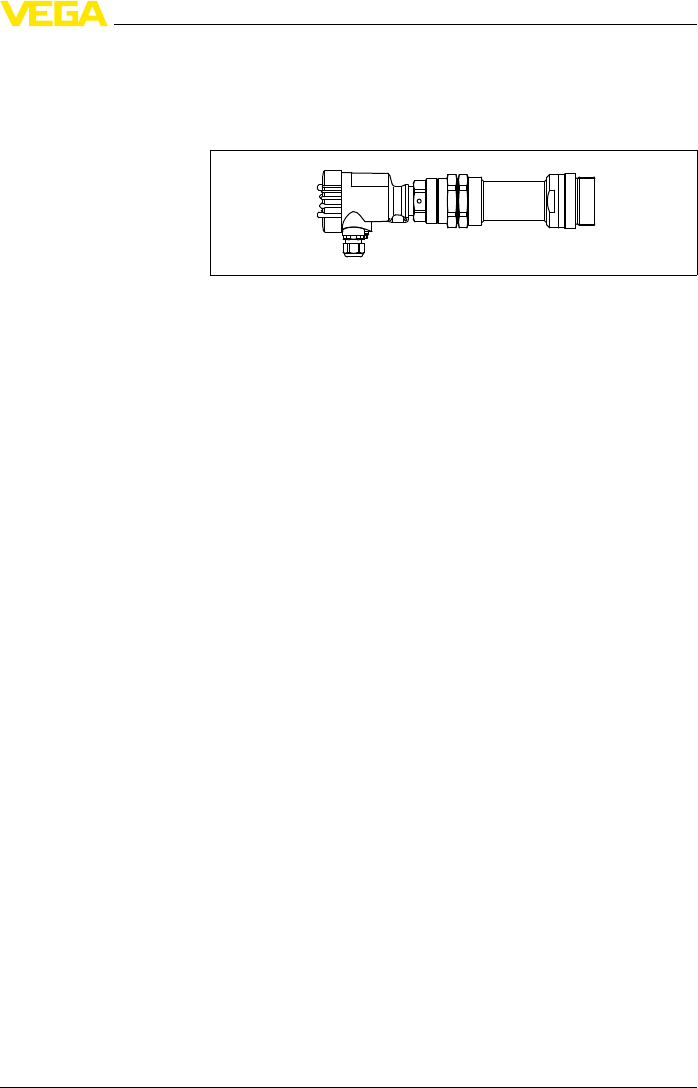
With high process temperatures exceeding 80 °C,you have to use a
mounting adapter for the emitting and receiving unit.The mounting
adapter can be only used with the encapsulated horn antenna with
PTFE cover.
Fig.3:VEGAMIP 61 with high temperature mounting adapter
Mounting adapter
VEGAMIP U61 • - Relay 11
3Product description
-EN-100531

4Mounting
4.1General instructions
With instruments with threaded process fitting,suitable tools must be
applied for tightening the hexagon.
Warning:
The housing must not be used to screw the instrument in!Applying
tightening force can damage internal parts of the housing.
Make sure that all parts of the instrument exposed to the process,in
particular the antenna,seal and process fitting,are suitable for the
existing process conditions.These include above all the process
pressure,process temperature as well as the chemical properties of
the medium.
You can find the specifications in chapter "Technical data"or on the
type label.
Use the recommended cables (see chapter "Connecting to power
supply")and tighten the cable gland.
You can give your instrument additional protection against moisture
penetration by leading the connection cable downward in front of the
cable entry.Rain and condensation water can thus drain off.This
applies mainly to outdoor mounting as well as installation in areas
where high humidity is expected (e.g.through cleaning processes)or
on cooled or heated vessels.
4.2Mounting instructions
If possible,install VEGAMIP 61 in a position where a high signal
damping by the medium is expected.
Screwing in
Suitability for the pro-
cess conditions
Moisture
Switching point
12 VEGAMIP U61 • - Relay
4Mounting
-EN-100531
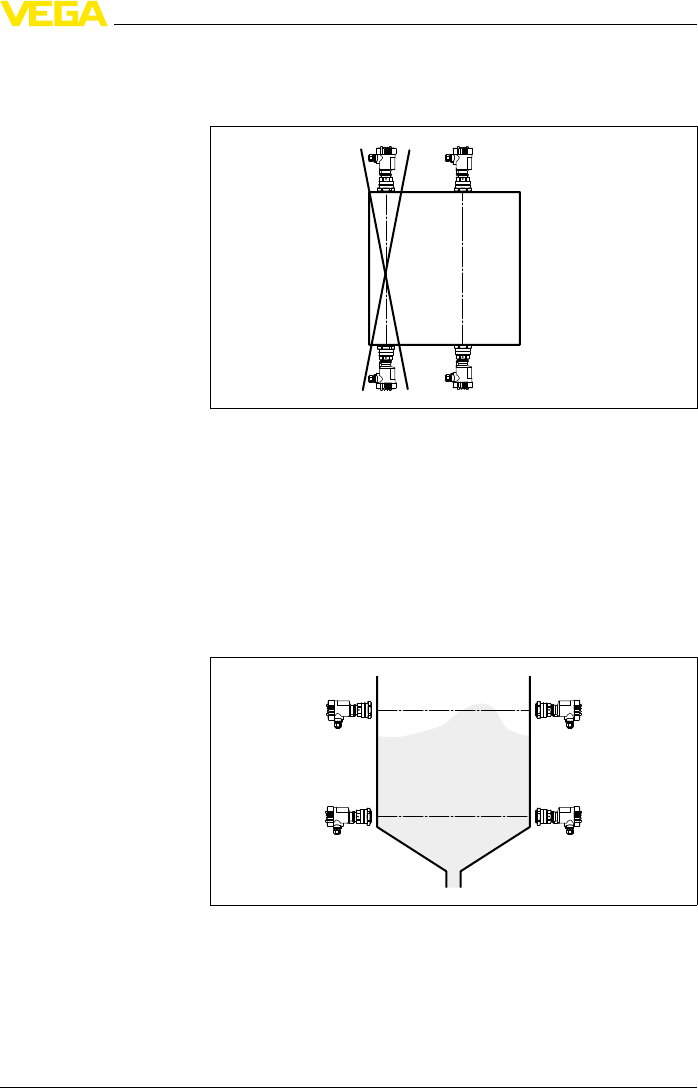
Avoid mounting the instrument too close to the vessel wall.Reflections
from the vessel wall or from vessel installation can influence the
switching accuracy.
Fig.4:Installation position (top view)
IfVEGAMIP 61 is mounted in the filling stream,unwanted false
measurement signals can be generated.For this reason,mount
VEGAMIP 61 at a position in the vessel where no disturbances,e.g.
from filling openings,agitators,etc., can occur.
Microwaves can penetrate non-conductive materials.Hence,it is
possible to measure through the wall of non-conductive vessels.
Fig.5:Bulk solids vessel of plastic
In metal vessels,you have to mount VEGAMIP 61 on flanges or
threaded sockets.It is also possible to measure through a window.In
general,all products such as glass,ceramic and plastic are suitable as
window material.
Inflowing medium
Non-metallic vessels
Metal vessels
VEGAMIP U61 • - Relay 13
4Mounting
-EN-100531
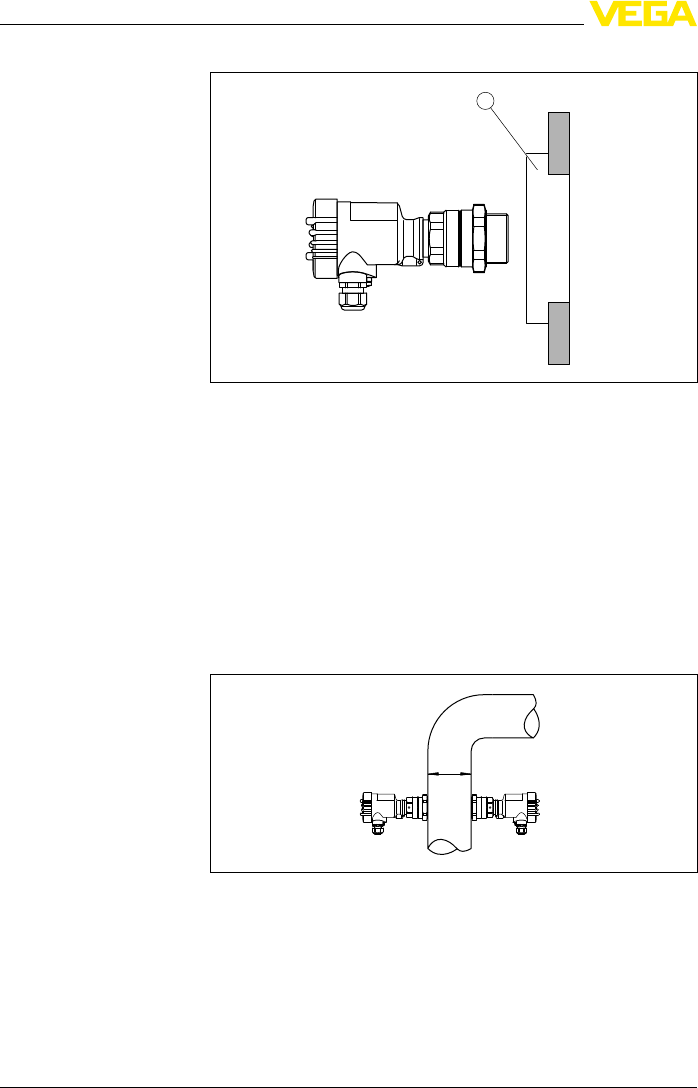
1
Fig.6:Installation in front of a vessel window
1Window of non-conductive material,for example,glass,plastic,etc.
In general,the same as for metal vessels applies to concrete vessels
due to the steel braining.
In general,the same as for metal vessels applies to wood vessels due
to the liquid absorption of the wood.
VEGAMIP 61 can be used for detection of products in pipelines.In
pipelines of non-metallic products such as plastic or glass,the
measured product can be detected through the pipe wall.
x
Fig.7:Installation in pipelines
xMin.distance 100 mm (3.94 in)
Mount the threaded version of VEGAMIP 61 in the following way:
Concrete vessel
Wood vessels
Pipelines
Threaded version
14 VEGAMIP U61 • - Relay
4Mounting
-EN-100531
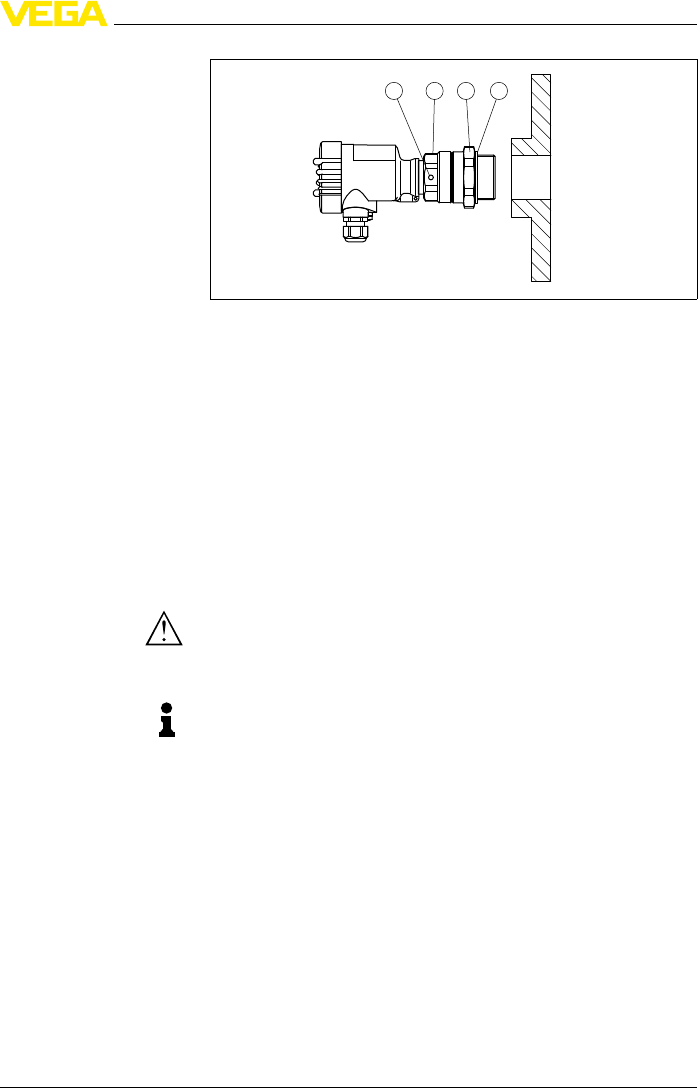
1 2 34
Fig.8:VEGAMIP 61 -threaded version G1½A
1Polarisation marking
2Instrument hexagon
3Locknut
4Process seal
1Insert the supplied process seal (1)before screwing it in
2To screw VEGAMIP 61 in,use the instrument hexagon (3)below
the housing.
Screw the instrument in and hand-screw it a flat wrench
3Turn the sensor back (max.180°)to reach the required orientation
of the polarisation marking (4)
4Hold the instrument in this position and tighten with the counter nut
(2)
Caution:
The housing must not be used to screw the instrument in!Applying
tightening force can damage internal parts of the housing.
Note:
In the case of VEGAMIP 61 with NPT thread,the instrument seals in
the thread itself.Hence,no counter nut is necessary for these
versions.
Avoid long sockets in which the medium can remain and if possible,
mount VEGAMIP 61 front-flush.This applies mainly if buildup and dust
are expected.
Buildup
VEGAMIP U61 • - Relay 15
4Mounting
-EN-100531
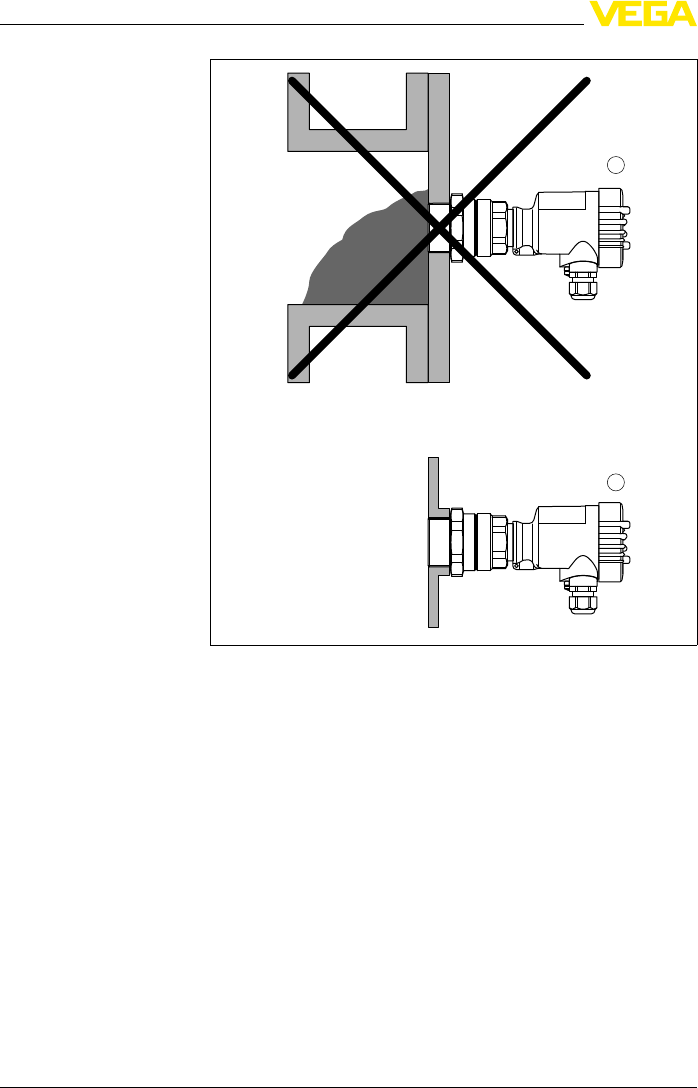
2
1
Fig.9:Front-flush installation
1Unfavourable installation -bulk solid can settle in front of the sensor
2Correct front flush installation
In very abrasive products,VEGAMIP 61 should be installed with a
mounting adapter or in front of a suitable window.In this case,you
have to use a window material which is appropriately resistant.
For an optimum switching signal,the two sensors must be adapted to
each other.The accuracy must be in a range of ±5°.
General rule:the bigger the antenna and the better it focusses,the
more precise the orientation has to be.
Abrasive medium
Orientation of the sensor
16 VEGAMIP U61 • - Relay
4Mounting
-EN-100531
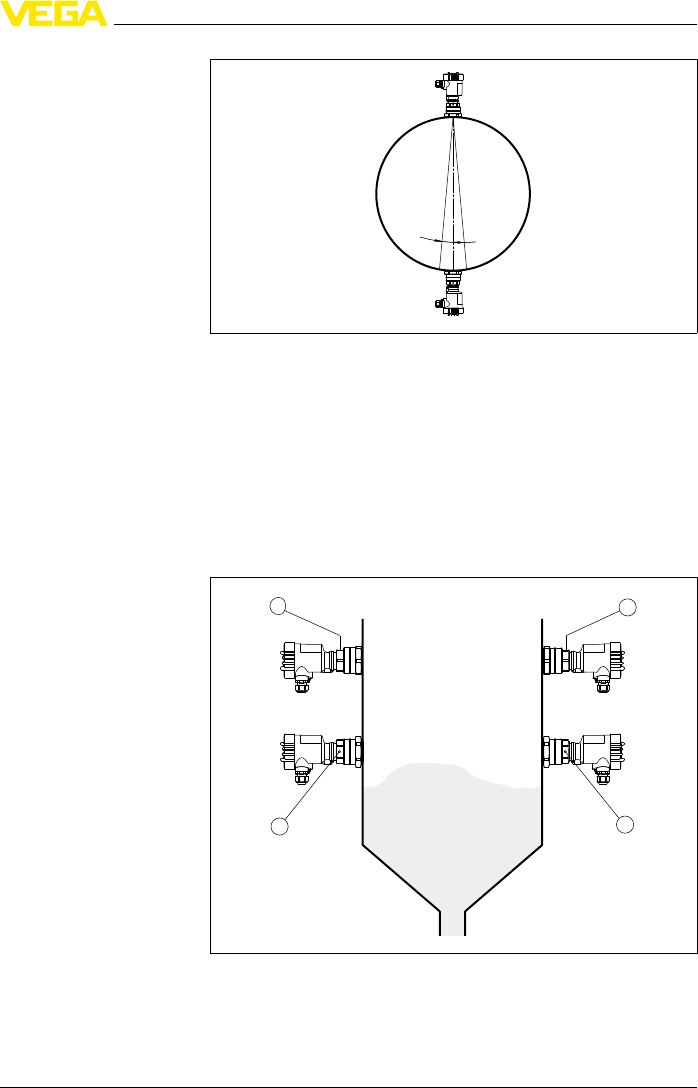
5°
+
-
Fig.10:Orientation of the sensors
The emitting unit emits electromagnetic waves.The polarisation plane
is the direction of the electrical wave component.Its position is marked
on the instrument hexagon by polarisation markings.
For a reliable function,the emitting and receiving unit must be installed
in the same polarisation direction.
If several instrument pairs are installed in a vessel,the instrument pairs
can be coded by different polarisation positions to avoid that they
influence one another.
2
11
2
Fig.11:Orientation according to the polarisation direction
1Polarisation marking on top
2Polarisation marking lateral
VEGAMIP U61 • - Relay 17
4Mounting
-EN-100531
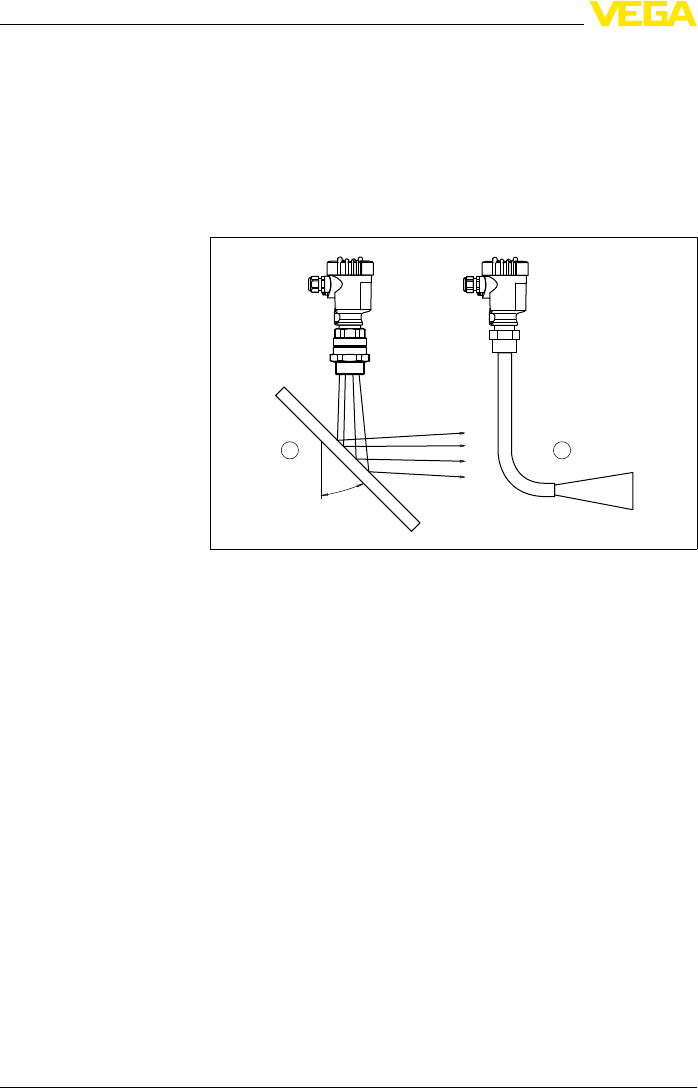
In tight mounting spaces or spaces subject to high temperatures,the
signal of VEGAMIP 61 can be guided via a deflector.You can use a
metal plate for this or an angled antenna extension on the side of the
emitting unit.In products with low dielectric value,we recommend
using an instrument version with antenna extension because it
focusses the signal optimally and has no signal loss.With instrument
versions with detachable horn antenna,the antenna extension can be
retrofitted.
45°
1 2
Fig.12:Possibilities for signal deflection
1Metal plate for signal deflection of the microwave signal
2Bent antenna extension
Special mounting op-
tions
18 VEGAMIP U61 • - Relay
4Mounting
-EN-100531

5Connecting to power supply
5.1Preparing the connection
Always keep in mind the following safety instructions:
lConnect only in the complete absence of line voltage
lIf overvoltages are expected,install overvoltage arresters
Connect the operating voltage according to the following diagrams.
The oscillator with relay output is designed in protection class 1.To
maintain this protection class,it is absolutely necessary that the
ground conductor be connected to the internal ground terminal.Take
note of the general installation regulations.As a rule,connect
VEGAMIP 61 to vessel ground (PA), or in case of plastic vessels,to
the next ground potential.On the side of the housing there is a ground
terminal between the cable entries.This connection serves to drain off
electrostatic charges.InEx applications,the installation regulations for
hazardous areas must be given priority.
The data for power supply are specified in chapter "Technical data".
The instrument is connected with standard two-wire cable without
screen.If electromagnetic interference is expected which is above the
test values of EN 61326 for industrial areas,screened cable should be
used.
Use cable with round cross-section.Acable outer diameter of 5…9mm
(0.2…0.35 in)ensures the seal effect of the cable gland.If you are
using cable with a different diameter or cross-section,exchange the
seal or use a suitable cable gland.
5.2Connection procedure
The connection of the voltage supply and the signal output is carried
out via the spring-loaded terminals in the housing.
Proceed as follows:
1Unscrew the housing cover
2Loosen compression nut of the cable entry
3Remove approx.10 cm (4in)of the cable mantle,strip approx.
1cm (0.4in)of insulation from the ends of the individual wires
Safety instructions
Voltage supply
Connection cable
Connection technology
Connection procedure
VEGAMIP U61 • - Relay 19
5Connecting to power supply
-EN-100531
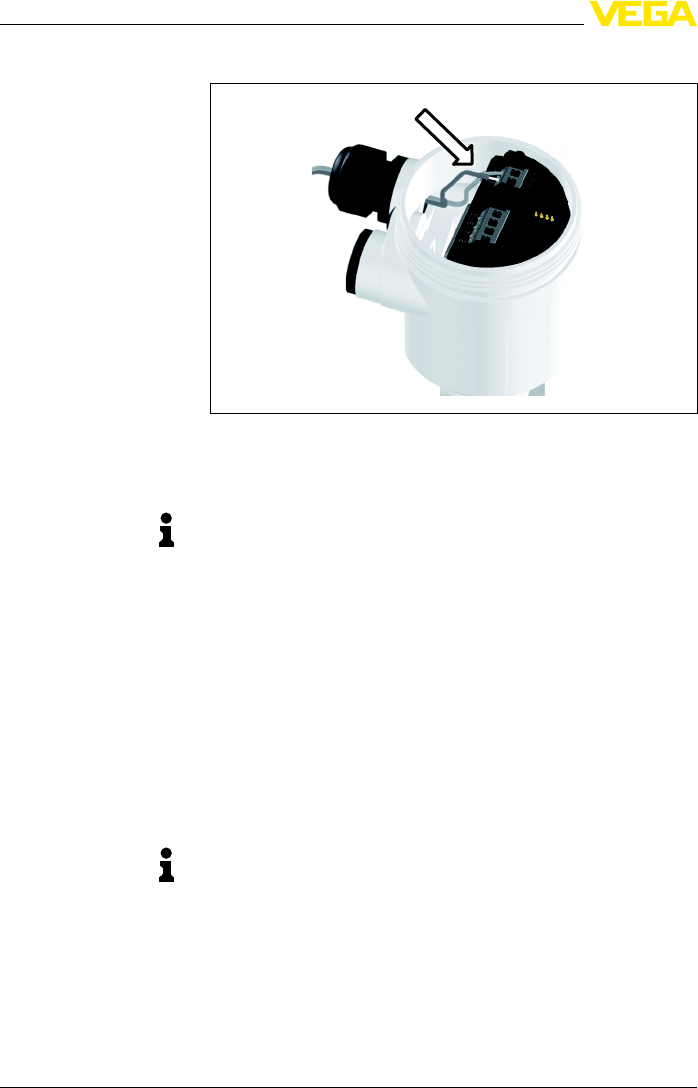
4Insert the cable into the sensor through the cable entry
Fig.13:Connection steps 4and 5
5Insert the wire ends into the terminals according to the wiring plan
Information:
Solid cores as well as flexible (stranded)cores with wire end sleeves
are inserted directly into the terminal openings.If you are using flexible
cores without end sleeves,press with a small screwdriver on the
terminal,the terminal opening is freed.When the screwdriver is
released,the terminal closes again.
6Check the hold of the wires in the terminals by lightly pulling on
them
7Connect the screen to the internal ground terminal,connect the
outer ground terminal to potential equalisation
8Tighten the compression nut of the cable entry.The seal ring must
completely encircle the cable
9Screw the housing cover on
The electrical connection is finished.
Information:
The terminal block is pluggable and can be removed from the
electronics.For this purpose,lift the terminal block with a small
screwdriver and pull it out.When inserting the terminal block again,
you should hear it snap in.
20 VEGAMIP U61 • - Relay
5Connecting to power supply
-EN-100531
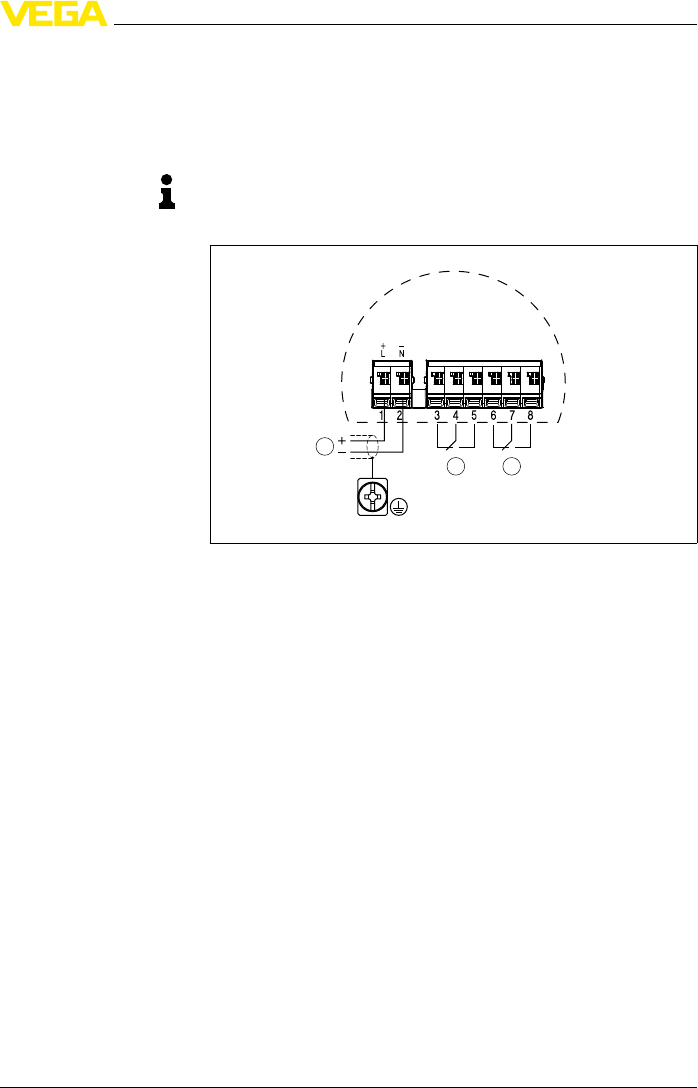
5.3Wiring plan,single chamber housing
We recommend connecting VEGAMIP 61 in such a way that the
switching circuit is open when there is a level signal,line break or
failure (safe condition).
Information:
The relays are always shown in non-operative condition.
3
2 1
Fig.14:Wiring plan receiving unit -VEGAMIP 61 (receiver)
1Relay output
2Relay output
3Voltage supply
Wiring plan
VEGAMIP U61 • - Relay 21
5Connecting to power supply
-EN-100531
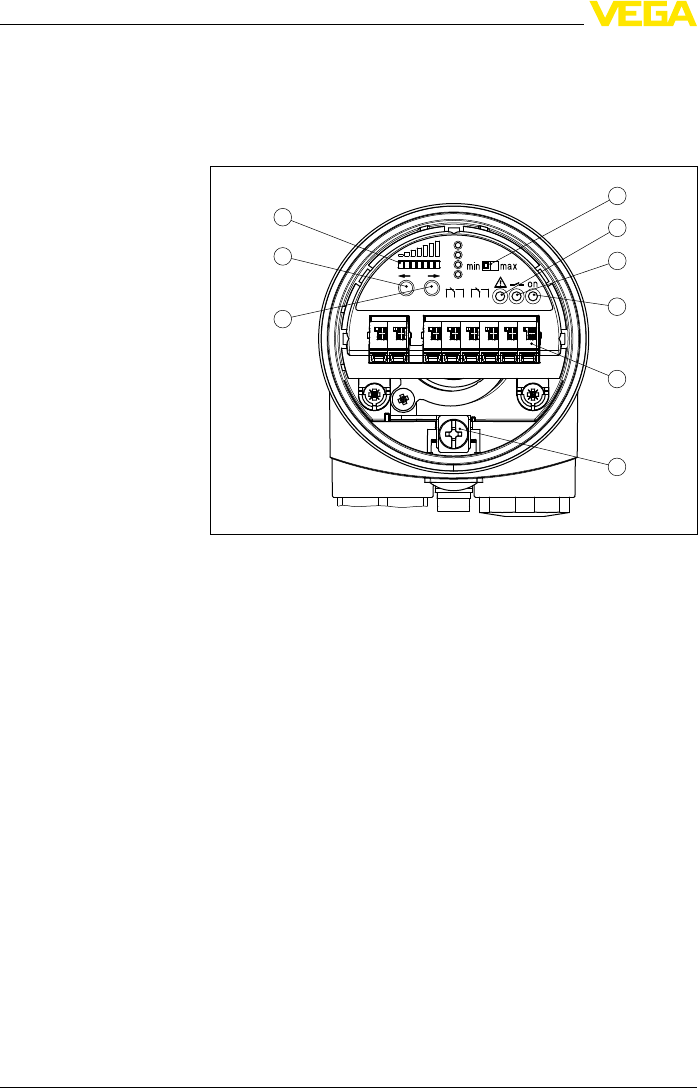
6Setup
6.1Adjustment elements
The figures in brackets refer to the following illustration.
6
7
9
8
4
5
1
2
3
1
L N 3
(-)( )
4 5 6 7 8
2
+34 5 6 7 8
Fig.15:Electronics module MPE60Rreceiver unit -Relay output
1Mode switch for selecting the switching behaviour (min./max.)
2Control lamp (LED)for indication of a fault (red)
3Signal lamp (LED)for indication of the switching condition (yellow)
4Control lamp (LED)for indication of the instrument function (green)
5Connection terminals
6Ground terminal
7Key for adjustment of the sensitivity and the switching delay (-->)
8Key for adjustment of the sensitivity and the switching delay (<--)
9LED indicating board for indication of the receiving level (yellow)
There are three signal lamps (LED)on the electronics module
Control lamp (red)for indication of a fault (2)
This signal lamp shows the fault status of the instrument.
Control lamp (yellow)for indication of the switching condition (3)
The signal lamp signals the switching condition of the switching output.
Control lamp (green)for indication of the instrument function (4)
The green signal lamp (on)shows the operating state of the instrument
as soon as voltage supply is connected correctly.
Signal lamps (2,3,4)
22 VEGAMIP U61 • - Relay
6Setup
-EN-100531
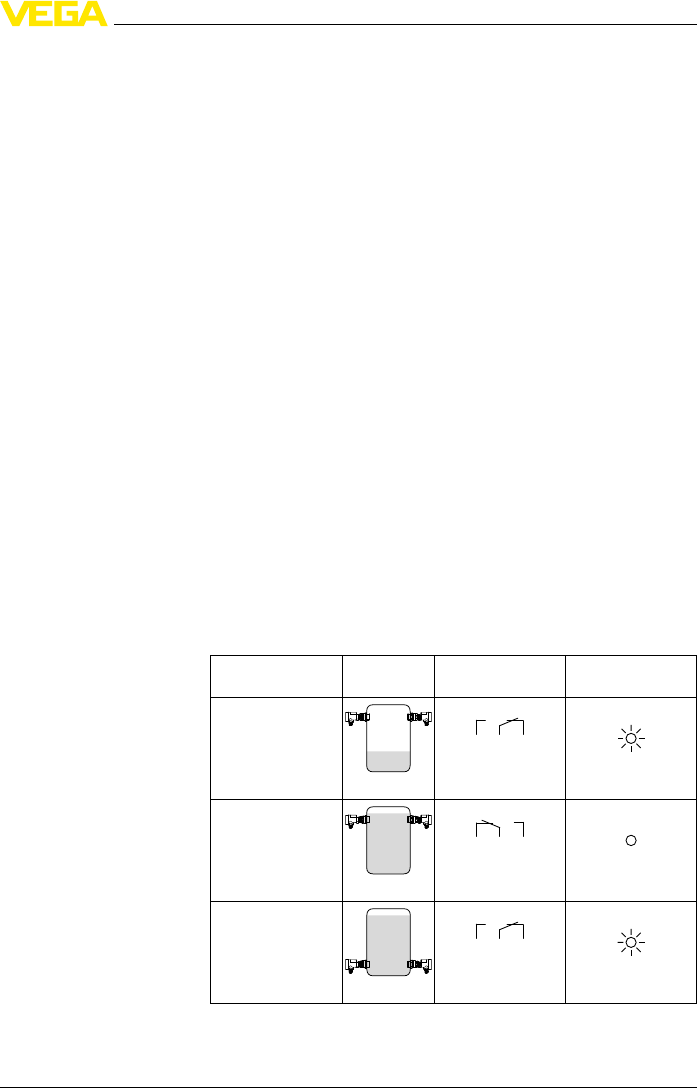
With the mode adjustment (max./min.) you can change the switching
condition of the relay.You can set the required mode according to the
"Function chart"(max. - max.detection or overflow protection,min. -
min.detection or dry run protection).
With these keys (7and 8)you can adjust the switching point to the
medium.
Depending on the process,the sensitivity of VEGAMIP 61 adjusted
more or less sensitive.
Pressing the "<--"key makes the sensor more sensitive.Pressing the
"-->" key makes the sensor less sensitive.
You can also adjust the switching delay with the two keys.
By means of the LED indicating board,you can see the actual
receiving level during adjustment.
When the indication moves to the right,the instrument will be more
insensitive,to the left more sensitive.
6.2Adjustment
The microwave barrier can only be adjusted when being uncovered.
Make sure that there is no measured medium or vessel installations
between the emitting and receiving unit.
Select the requested mode (min./max.) according to the function chart.
The following function chart provides an overview of the switching
conditions depending on the adjusted mode and level.
Level Switching status Signal lamp -Re-
lay (yellow)
Mode max.
Overflow protection
53 4
(8)(6) (7)
Relay energized
Mode max.
Overflow protection
53 4
(8)(6) (7)
Relay deenergized
Mode min.
Dry run protection
53 4
(8)(6) (7)
Relay energized
Mode adjustment (1)
Sensitivity adjustment
(7,8)
LED indication strip -
receiving level (9)
Prerequisites
Mode
VEGAMIP U61 • - Relay 23
6Setup
-EN-100531
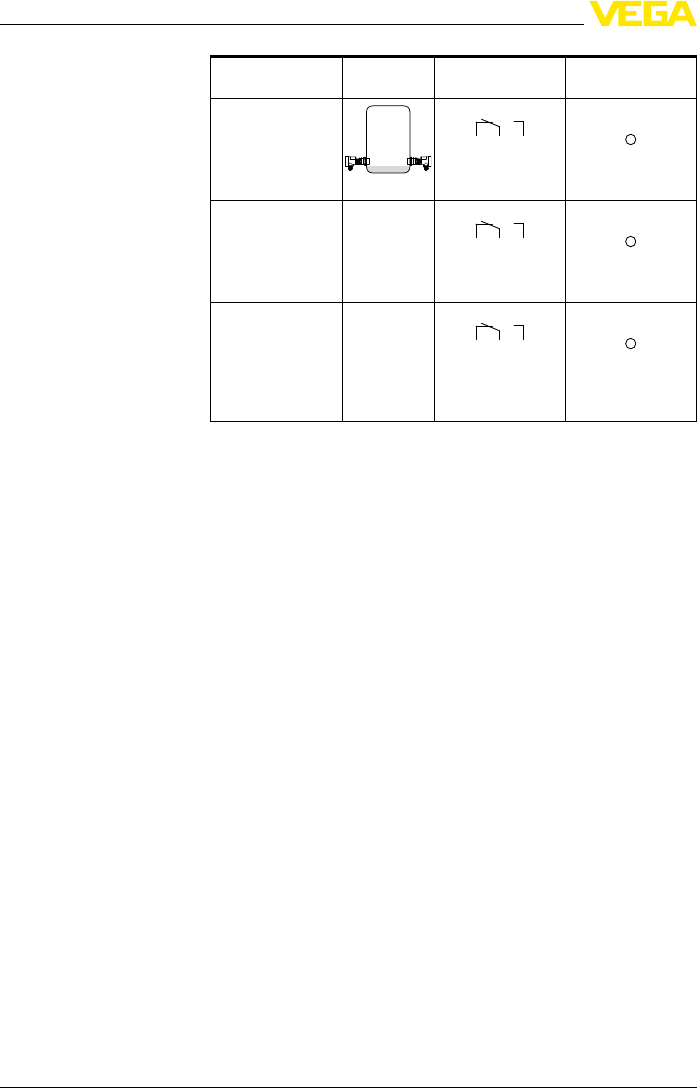
Level Switching status Signal lamp -Re-
lay (yellow)
Mode min.
Dry run protection
53 4
(8)(6) (7)
Relay deenergized
Failure of the supply
voltage
(max./min.mode)
any
53 4
(8)(6) (7)
Relay deenergized
Failure any
53 4
(8)(6) (7)
Relay deenergized Red failure LED
lights
Depending on the switching function your relay output should carry
out,you can determine the switching direction by means of the slide
switch.
lFor max.indication or overfill protection set the slide switch to
position max.
lFor min.indication or dry run protection,set the slide switch to
position min.
The relay is energized if the yellow relay control lamp lights.
With the two keys you can change the LED indication strip and adjust
the switching point to the medium.
The keys are lowered to avoid unintentional changes of the setting.For
adjustment,use for example,a small screwdriver.
If you press one of the keys for more than two seconds,the adjustment
range shifts automatically in the respective direction.The greater the
distance between emitting and receiving unit,the greater the adjust-
ment range of the indication.The LED indication strip always shows a
small section of the actual measuring range.
Pressing the "<--"key makes the sensor more sensitive.Pressing the
"-->" key makes the sensor less sensitive.
Sensitivity adjustment
24 VEGAMIP U61 • - Relay
6Setup
-EN-100531
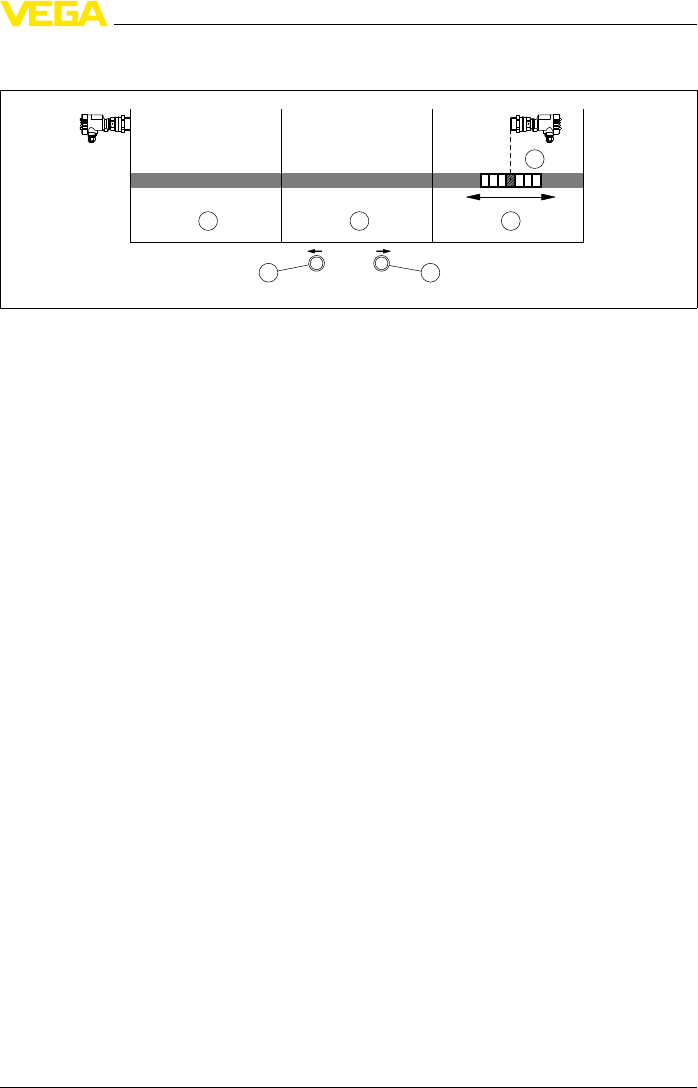
Press the respective key until the indication is within the LED indication
strip.This means one or two LEDs on the LED indication strip light up.
1
CBA
23
Fig.29:Indication board
1Indication (LED indication board)
2More sensitive -Key to the left
3Less sensitive -Key to the right
A Medium:Plastics (PP,PVC …), solvents
B Medium:Building material (sand,stones …)
C Medium:Conductive substances (coal,ore,salt …)
Set the indication approximately to the middle of the LED indicating
board until the yellow relay control lamp changes condition.
Depending on the vessel size,process and/or medium,you have to
adjust the sensitivity of VEGAMIP 61 more or less sensitive.In
products with low signal damping,in small vessels or pipelines or with
buildup,it can be necessary to test the switching function.
By means of the LED indicating board,you can see the actual
receiving level during adjustment.
When the indication moves to the right,the instrument will be more
insensitive,to the left more sensitive.
In applications with products having a good signal damping (for
example stones,ore,sand,cement)and where buildup and
contamination is expected,you should adjust the instrument more
insensitive.In this case,the VEGAMIP 61 switches only with a
relatively high signal damping by the medium.Probable buildup does
not influence the measurement.
Receiving level
Medium delivers good
signal damping
VEGAMIP U61 • - Relay 25
6Setup
-EN-100531
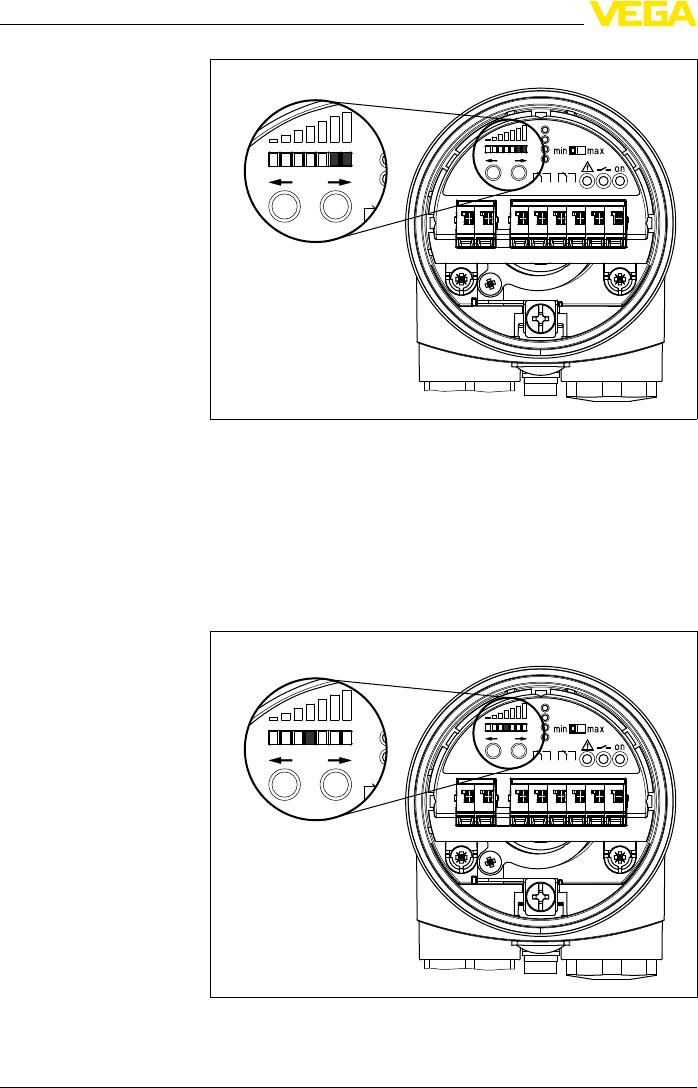
1
L N 3
(-)( )
4 5 6 7 8
2
+34 5 6 7 8
Fig.30:LED indication strip -Setting for products with good signal damping
In applications with products having a low signal damping (for example
plastic granules,cereals), you should adjust the instrument more
sensitive.Hence,the VEGAMIP 61 switches very sensitive,even with
relatively low covering by the product.
1
L N 3
(-)( )
4 5 6 7 8
2
+34 5 6 7 8
Fig.31:LED indication strip -Setting for products with low signal damping
Product delivers low
signal damping
26 VEGAMIP U61 • - Relay
6Setup
-EN-100531
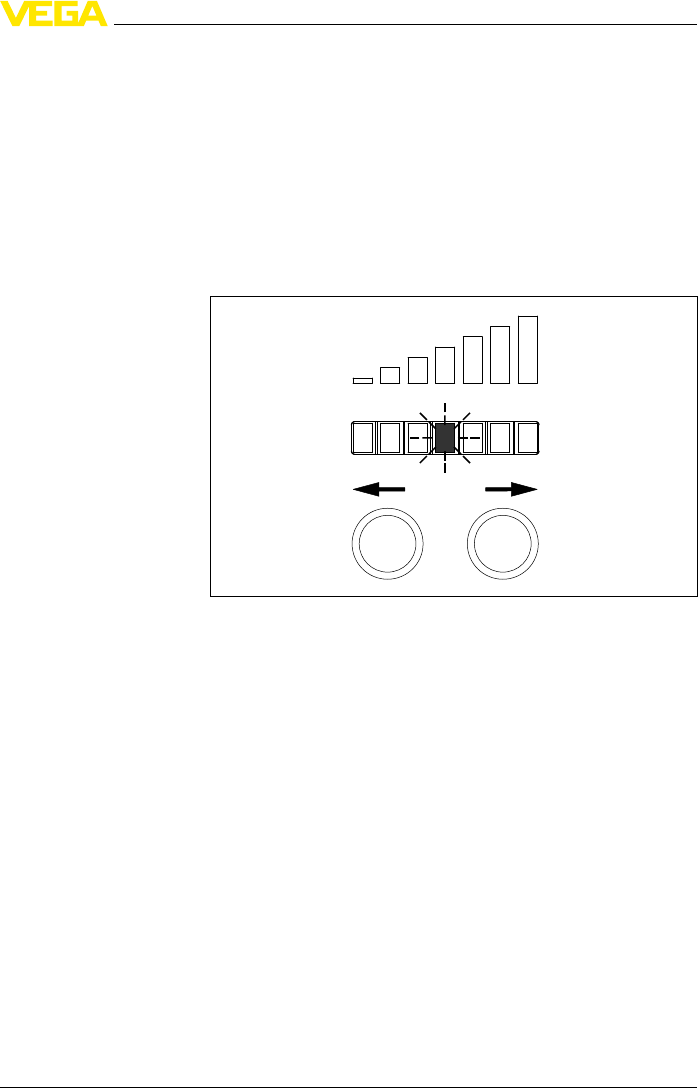
By means of the LED indicating board,you can adjust the switching
delay.
Push the two keys (7)and (8)simultaneously for approximately 2s
until the LED indication flashes.
With the two keys you can select the requested switching delay
according to the following illustration.
The switching delay can be adjusted in seven steps between 100 ms
and 20 s.
200
ms
100
ms 500
ms 1 s 2 s 5 s 20 s
Fig.32:Adjust switching delay -LED indication flashes
If the indication moves to the right,the switching delay will be longer,to
the left shorter.
The indication returns automatically to the indication of the actual
receiving level after approximately 10 s.
If possible,you can simulate a filling between emitting and receiving
unit by using the hand or a metal sheet and check if the switching point
is adjusted correctly.If the relay control lamp changes the switching
condition,then the switching function is correct.
Switching delay
Simulation
VEGAMIP U61 • - Relay 27
6Setup
-EN-100531

7Maintenance and fault rectification
7.1Maintenance
When the device is used correctly,no maintenance is required in
normal operation.
7.2Rectify malfunctions
The operator of the system is responsible for taking suitable measures
to remove interferences.
The first measure to be taken is to check the output signal.In many
cases,the causes can be determined this way and the faults rectified.
Error Cause Removal
VEGAMIP 61 signals
"covered"when the vibra-
ting element is not sub-
merged (overfill protection)
or
VEGAMIP 61 signals
"uncovered"when the vib-
rating element is submer-
ged (dry run protection)
Operating voltage too low Check operating voltage
Buildup on the sensor Check if there is buildup on the two sensors,and if so,
remove it.
Wrong mode selected Set the correct mode on the mode switch (max.:
overflow protection,min.: dry run protection). Wiring
should be carried out according to the quiescent current
principle.
Unfavourable installation
location
Mount the sensor (emitter/receiver)in a position where
there is a lot of measured product between emitting and
receiving unit.
Electronics defective Press the mode switch.If the instrument then does not
change the mode,the electronics module is defective.
Exchange the electronics module.
Sensor defective Push the mode switch (min./max.). If the instrument
switches over,the sensor can be covered or mechani-
cally damaged.
Should the switching function on the correct mode be
wrong again,the you should return the instrument for
repair.
Signal lamp lights red Operating voltage too low Check operating voltage
Electronics module has
detected an internal failure
Exchange the instrument or send it in for repair
Instrument switches de-
layed
Check switching delay Adjust switching delay correctly
Reaction when malfunc-
tions occur
Fault rectification
Checking the switching
signal
28 VEGAMIP U61 • - Relay
7Maintenance and fault rectification
-EN-100531

Depending on the failure reason and measures taken,the steps
described in chapter "Set up"must be carried out again,if necessary.
However,should these measures not be successful,call the VEGA
service hotline in urgent cases under the phone no.+49 1805 858550.
The hotline is available to you 7days a week round-the-clock.Since
we offer this service world-wide,the support is only available in the
English language.The service is free of charge,only the standard
telephone costs will be charged.
7.3Exchange the electronics
If the electronics module is defective,it can be replaced by the user.
InEx applications only one electronics module with respective Ex
approval may be used.
You find all information to the electronics exchange in the operating
instructions of the new electronics module.
7.4How to proceed in case of repair
If a repair is necessary,please proceed as follows:
You can download a return form (23 KB)from our Internet homepage
www.vega.com under:"Downloads -Forms and certificates -Repair
form".
By doing this you help us carry out the repair quickly and without
having to call back for needed information.
lPrint and fill out one form per instrument
lClean the instrument and pack it damage-proof
lAttach the completed form and,if need be,also a safety data
sheet outside on the packaging
lPlease ask the agency serving you for the address of your return
shipment.You can find the competent agency on our website
www.vega.com.
Reaction after fault rec-
tification
24 hour service hotline
VEGAMIP U61 • - Relay 29
7Maintenance and fault rectification
-EN-100531

8Dismounting
8.1Dismounting steps
Warning:
Before dismounting,be aware of dangerous process conditions such
as e.g.pressure in the vessel,high temperatures,corrosive or toxic
products etc.
Take note of chapters "Mounting"and "Connecting to power supply"
and carry out the listed steps in reverse order.
8.2Disposal
The instrument consists of materials which can be recycled by
specialised recycling companies.We use recyclable materials and
have designed the electronics to be easily separable.
WEEE directive 2002/96/EG
This instrument is not subject to the WEEE directive 2002/96/EG and
the respective national laws.Pass the instrument directly on to a
specialised recycling company and do not use the municipal collecting
points.These may be used only for privately used products according
to the WEEE directive.
Correct disposal avoids negative effects to persons and environment
and ensures recycling of useful raw materials.
Materials:see chapter "Technical data"
If you have no possibility to dispose of the old instrument
professionally,please contact us concerning return and disposal.
30 VEGAMIP U61 • - Relay
8Dismounting
-EN-100531

9Supplement
9.1Technical data
General data
Material 316Lcorresponds to 1.4404 or 1.4435
Materials,wetted parts
-Process fitting -thread 316L
-Process fitting -flange 316L
-Process seal Klingersil C-4400
-Instrument seal FKM (Viton)
-Antenna cover PP,PTFE
-Cover -Mounting adapter (optional)Ceramic Al
2
0
3
-Seal -Mounting adapter (optional)Graphite
Materials,non-wetted parts
-Housing plastic plastic PBT (Polyester)
-Aluminium die-casting housing Aluminium die-casting AlSi10Mg,powder-coated -
basis:Polyester
-Stainless steel housing -precision cast-
ing
316L
-Stainless steel housing,electropolished 316L
-Seal between housing and housing
cover
NBR (stainless steel housing,investment casting),
silicone (Aluminium/plastic housing,stainless steel
housing,electro-polished)
-Ground terminal 316L
-Mounting adapter (option)316L
Sensor length See chapter "Dimensions"
Instrument weight (depending on process
fitting)
0.8…4kg (0.18 …8.82 lbs)
Process fittings
-Pipe thread,cylindrical (ISO 228 T1)G1½A
-American pipe thread,tapered 1½NPT
-Flanges DIN from DN 50,ANSI from 2"
Frequency range Kband,24.085 GHz(ISM band)
Measuring range 0.1…100 m(0.33 …328 ft)
Angle of aperture of the antenna 3dB
-Encapsulated horn antenna (G1½A)20 °
-Plastic encapsulated antenna with PP
cover
10 °
Output variable
Output Relay output,2floating spdts
VEGAMIP U61 • - Relay 31
9Supplement
-EN-100531

Relay data
-AC 5A,253 V AC
-DC 4A,30 V DC;0.2A,125 V DC
Breaking capacity If inductive loads or stronger currents are switched
through,the gold plating on the relay contact
surface will be permanently damaged.The contact
is then no longer suitable for switching low-level
signal circuits.
Contact material (relay contacts)AgNi or AgSnOand Au plated
Modes (adjustable)
-max.Max.detection or overflow/overfill protection
-min.Min.detection or dry run protection
Measuring accuracy
Hysteresis approximately 1dB
Switching delay adjustable from 0.1…20 s(on/off)
Min.distance 100 mm (3.94 in)
Ambient conditions
Ambient,storage and transport temperature -40 …+80 °C(-40 …+176 °F)
Process conditions
Measured variable Limit level of bulk solids and liquids
Process pressure
-VEGAMIP 61 antenna with PTFE cover -1…4bar/-100 …400 kPa(-14.5…58 psig)
-VEGAMIP 61 antenna with PP cover -1…2bar/-100 …200 kPa(-14.5…29 psig)
-VEGAMIP 61 with mounting adapter unpressurized (IP 67)
Process temperature (thread or flange tem-
perature)
-VEGAMIP 61 antenna with PTFE cover -40 …+80 °C(-40 …+176 °F)
-VEGAMIP 61 antenna with PP cover -40 …+80 °C(-40 …+176 °F)
-VEGAMIP 61 with mounting adapter
150 mm (optional)
-40 …+250 °C(-40 …+482 °F)
-VEGAMIP 61 with mounting adapter
300 mm (optional)
-40 …+450 °C(-40 …+842 °F)
Electromechanical data
Cable entry/plug (dependent on the version)
-Single chamber housing l1x cable entry M20 x1.5(cable:ø5…9mm),
1x blind stopper M20 x1.5;attached 1x cable
entry M20 x1.5
or:
32 VEGAMIP U61 • - Relay
9Supplement
-EN-100531

l1x cable entry ½NPT,1x blind stopper ½NPT,
1x cable entry ½NPT
or:
l1x plug M12 x1;1x blind stopper M20 x1.5
Screw terminals for wire cross-section up to 1.5mm²(AWG 16)
Voltage supply
Operating voltage 20 …253 V AC,50/60 Hz,20 …72 V DC (at
U>60 V DC,the ambient temperature can be max.
50 °C/122 °F)
Power consumption 1…8VA (AC), approximately 1.3W(DC)
Electrical protective measures
Protection rating IP 66/IP 67
Overvoltage category III
Protection class I
Approvals
Depending on the version,instruments with approvals can have different technical data.
For these instruments,the corresponding approval documents have to be taken into account.
These are part of the delivery or can be downloaded under www.vega.com via "VEGA Tools"and
"serial number search"as well as via "Downloads"and "Approvals".
VEGAMIP U61 • - Relay 33
9Supplement
-EN-100531
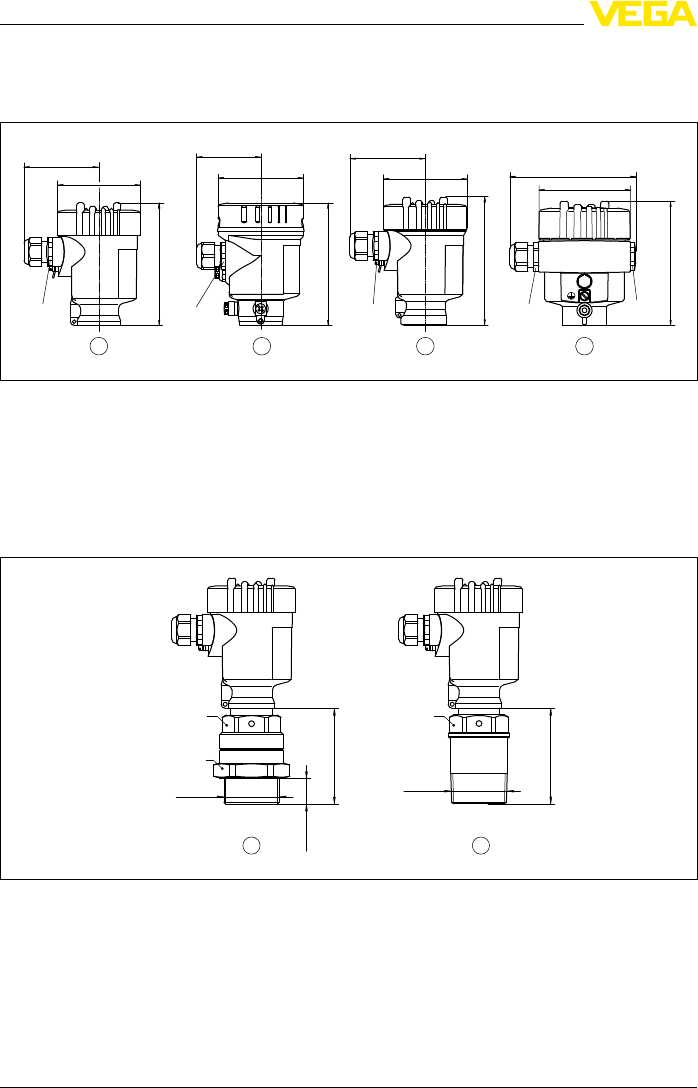
9.2Dimensions
VEGAMIP 61 -housing versions
~ 69 mm
(2 23/32") ø 77 mm
(3 1/32")
112 mm (4 13/32")
M20x1,5/
½ NPT
~ 69 mm
(2 23/32") ø 77 mm
(3 1/32")
117 mm (4 39/64")
M20x1,5/
½ NPT
~ 116 mm (4 9/16")
ø 84 mm (3 5/16")
116 mm (4 9/16")
M20x1,5M20x1,5/
½ NPT
~ 59 mm
(2 21/64") ø 80 mm
(3 5/32")
112 mm (4 13/32")
M20x1,5/
½ NPT
1 3 4
2
Fig.33:Housing versions
1Housing plastic
2Stainless steel housing,electropolished
3Stainless steel housing -precision casting
4Aluminium housing
VEGAMIP 61
22mm
(0.87")
83mm (3.27")
SW 46 mm
(1.42")
SW 46 mm
(1.42")
SW 60 mm
(1.42")
G1½ A 1½ NPT
83mm (3.27")
1 2
Fig.34:VEGAMIP 61
1Threaded version -encapsulated horn antenna with PTFE cover -G1½A
2Threaded version -encapsulated horn antenna with PTFE cover -1½NPT
34 VEGAMIP U61 • - Relay
9Supplement
-EN-100531
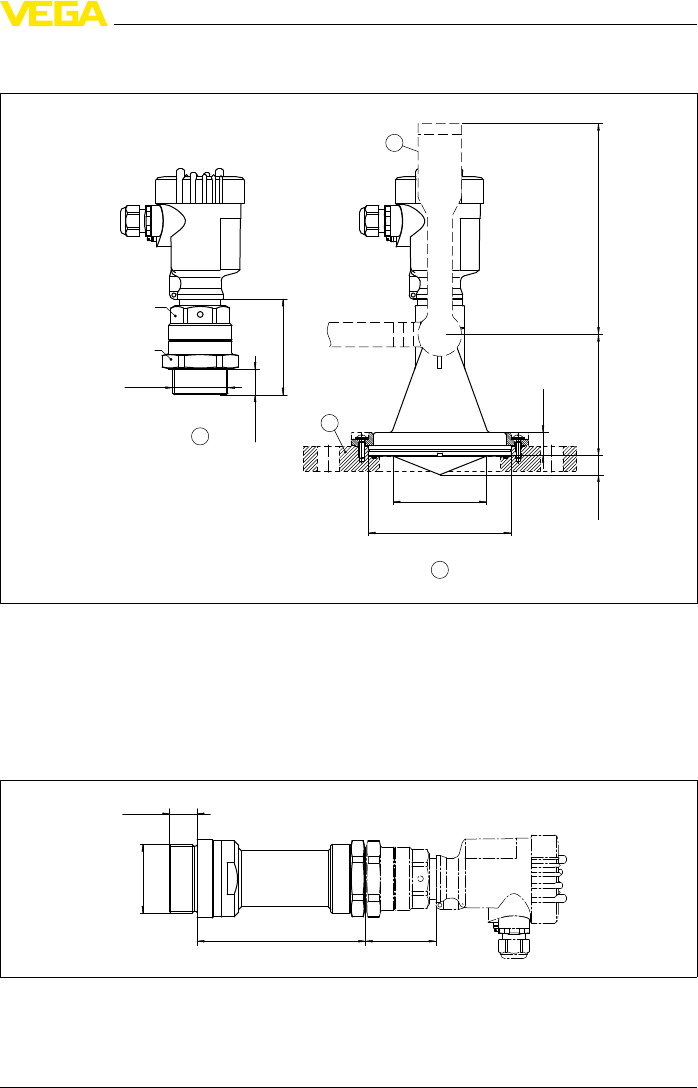
VEGAMIP 61
22mm
(0.87")
83mm (3.27")
SW 46 mm
(1.42")
SW 60 mm
(1.42")
G1½ A
2
14
3
15 mm
(0.59")
98 mm
(3.86")
170 mm / 300 mm
(6.69") / (11.81")
19 mm
(0.75")
ø 75 mm
(2.95")
ø 115 mm
(4.53")
Fig.35:VEGAMIP 61
1Threaded version -encapsulated horn antenna with PTFE cover -G1½A
2Plastic encapsulated antenna with PP cover
3Mounting strap
4Adapter flange
VEGAMIP 61 -Mounting adapter (-40 …+450 °C)
24mm
(0.95")
x 61 mm
(2.4")
G2 A
Fig.36:Mounting adapter with ceramic cover for VEGAMIP 61 -threaded version with PTFE cover
x150 mm (5.9in)or 300 mm (11.8in)
VEGAMIP U61 • - Relay 35
9Supplement
-EN-100531

9.3Industrial property rights
VEGA product lines are global protected by industrial property rights.
Further information see http://www.vega.com.
Only in U.S.A.: Further information see patent label at the sensor
housing.
VEGA Produktfamilien sind weltweit geschützt durch gewerbliche
Schutzrechte.
Nähere Informationen unter http://www.vega.com.
Les lignes de produits VEGA sont globalement protégées par des
droits de propriétéintellectuelle. Pour plus d'informations, on pourra
se référer au site http://www.vega.com.
VEGA lineas de productos están protegidas por los derechos en el
campo de la propiedad industrial. Para mayor información revise la
pagina web http://www.vega.com.
Линии продукции фирмы ВЕГА защищаются по всему миру
правами на интеллектуальную собственность.Дальнейшую
информацию смотрите на сайте http://www.vega.com.
VEGA系列产品在全球享有知识产权保护。
进一步信息请参见网站<http://www.vega.com>。
9.4Trademark
All the brands as well as trade and company names used are property
of their lawful proprietor/originator.
36 VEGAMIP U61 • - Relay
9Supplement
-EN-100531

INDEX
A
Abrasion 16
Accessory
-Flanges 10
-Protective cover 10
Application area 7
B
Bending 18
Buildup 15
C
Cable 19
Cable screening 19
E
Electronics module 10,29
Emitting unit 8
F
Fault rectification 28
Filling opening 13
Functional principle 9
M
Mode 23
Moisture 12
Mounting adapter 11
O
Orientation of the sensor 16
P
Pipelines 14
Potential equalisation 19
R
Receiving unit 8,21-22
S
Sensitivity adjustment 24
Serial number 7
Service hotline 29
Shielding 19
Simulation 27
Switching delay 27
Switching point 12
T
Type label 7
V
Vessel type
-Concrete vessel 14
-Metal vessels 13
-Non-metallic vessels 13
-Wood vessels 14
VEGAMIP U61 • - Relay 37
Index
-EN-100531

38 VEGAMIP U61 • - Relay
Index
-EN-100531

VEGAMIP U61 • - Relay 39
Index
-EN-100531

VEGA Grieshaber KG
AmHohenstein 113
77761 Schiltach
Germany
Phone +49 7836 50-0
Fax +49 7836 50-201
E-mail:info@de.vega.com
www.vega.com
Printing date:
ISO 9001
All statements concerning scope of delivery,application,
practical use and operating conditions of the sensors and
processing systems correspond to the information avail-
able at the time of printing.
©VEGA Grieshaber KG,Schiltach/Germany 2010
Subject to change without prior notice -EN-100531